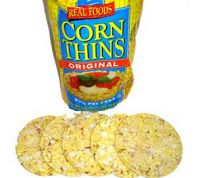The CAFC issued a spit decision in this appeal from the TTAB's February 21, 2017 ruling [TTABlogged here] sustaining oppositions to registration of CORN THINS for "crispbread slices predominantly of corn, namely popped corn cakes," and RICE THINS for "crispbread slices primarily made of rice, namely rice cakes" [CORN and RICE disclaimed]. The appellate court upheld the Board's findings that the marks are merely descriptive of the goods and lack acquired distinctiveness. However, the Board vacated the Board's conclusion that the mark are not generic for the goods, remanding the case for reconsideration of the genus selected by the Board for its analysis. Real Foods Pty., Ltd. v. Frito-Lay North America, Inc., Appeals No. 2017-1959, 2017-2009 (Fed. Cir. October 4, 2018) [precedential].

Mere Descriptiveness: Substantial evidence supported the Board's finding that the marks are "highly descriptive" of the goods. The terms "corn" and "rice" are descriptive because "they identify 'ingredients, " which are "qualities or properties" of the goods. The term "thins" describes physical characteristics of the goods. The composite terms do not create a different commercial impression; they immediately convey information of a quality or characteristic of the products.
Appellant Real Foods urged that the marks are double entendres, but the CAFC agreed with the Board that the marks have no additional suggestive meaning, since the word "thins" has been used with food products that are thin in shape. The existence of several third-party registrations for marks containing the word "thins" was of limited probative value, because each trademark application must be examined on its own merits.
Acquired Distinctiveness: Substantial evidence supported the Board's finding that Real Foods had failed to prove that the applied-for marks have acquired distinctiveness. According to the Board, Real Foods "has done little or no advertising," and its sales figures "while not insignificant, are not high." Moreover, the use of the term "thins" is not limited to applicant. Opposer Frito Lay's survey, showing less than 10% recognition of the mark as a source indicator, established the "limited recognition of CORN THINS as a mark."

Genericness: The Board identified the genus of the goods as "popped corn cakes" for CORN THINS and "rice cakes" for RICE THINS. The CAFC pointed out, however, that "[A] term can be generic for a genus of goods or services if the relevant public understands the term to refer to a key aspect of that genus." Royal Crown Co. v. Coca-Cola Co., 892 F.3d 1358, 1367 (Fed. Cir. 2018).
Furthermore, the question of registrability must be decided on the basis of the identification of the goods set forth in the application, regardless of the actual nature of the applicant's goods. In re Cordua at 602.
The TTAB improperly narrowed the genus of the goods at issue. The Applications initially identified the goods as "[c]rispbread slices predominantly of corn," J.A. 53, and "crispbread slices primarily made of rice," J.A. 209. During the opposition proceedings, Real Foods moved to amend the goods as "crispbread slices predominantly of corn, namely popped corn cakes" and "crispbread slices primarily made of rice, namely rice cakes," J.A. 279 (emphases added), and the TTAB granted Real Foods' motion to amend, Frito-Lay, 2017 WL 914086, at *21. In its Opinion, the TTAB defined the genus of the goods strictly by reference to the newly added portion of the amended language, identifying the genus as "popped corn cakes" for the CORN THINS mark and "rice cakes" for the RICE THINS mark. Id. at *4.
The Board failed to consider that the applications popped corn cakes and rice cakes are types of crispbread slices, "which, in turn, the record defines as types of crackers." This was error. "[C]orn cakes and rice cakes are the species, not the genus." The Board provided no reasoning for choosing the narrowed identification of goods as the genus.
The CAFC therefor remanded the case to the Board "to reconsider its selected genus and conduct is genericness analysis in light of that genus."
The content of this article is intended to provide a general guide to the subject matter. Specialist advice should be sought about your specific circumstances.
